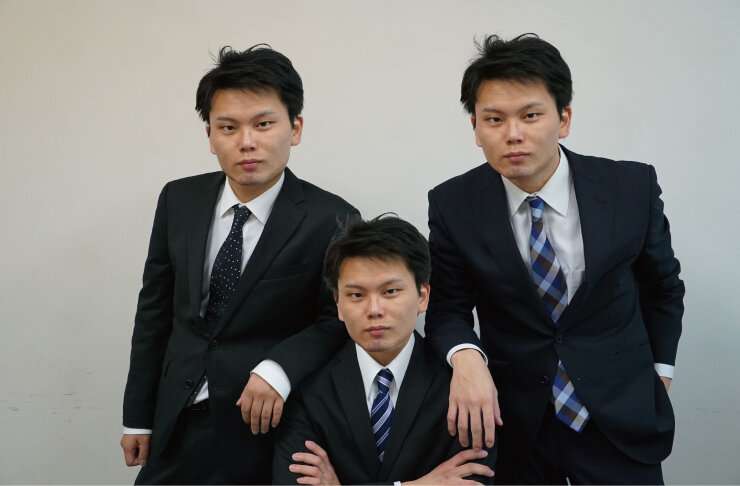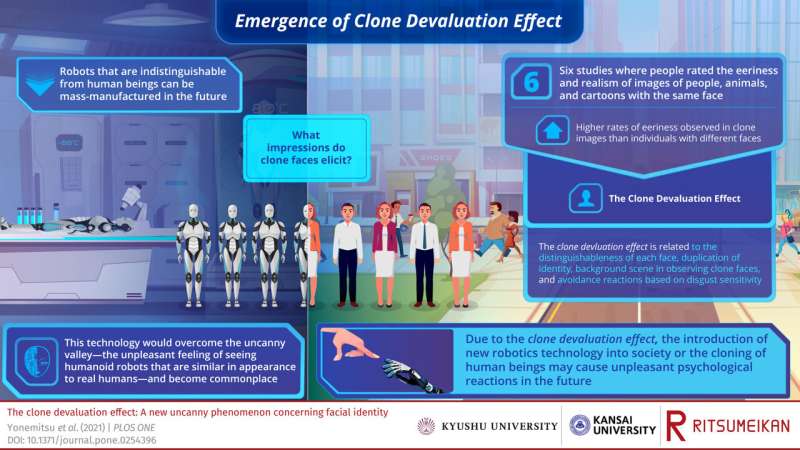Unease beyond the uncanny valley: How people react to the same faces

Increasingly, movies featuring humanoid robots, like Terminator or Ex Machina, are showing the titular “robot” akin to humans not only in intelligence but also appearance. What if Terminator-esque robots became the norm, making it difficult for us to tell them apart from actual human beings?
This is the premise of a new study published in PLOS ONE, which evaluated how human beings respond to images of people with the same face. It is not too far-fetched to imagine a future where human-like androids are mass-produced and are indistinguishable from flesh-and-blood human beings. Robotics and artificial intelligence are advancing at an unprecedented rate, with very closely human-like robots and CG characters, such as Geminoid, Saya, and Sophia already having been produced. Developers are optimistic they will one day create robots that surpass the uncanny valley—a well-known phenomenon where humanoids elicit unpleasant and negative emotions in viewers when their appearance becomes similar to that of humans.
In such a future, how would we react?
A team of researchers from Kyushu University, Ritsumeikan University, and Kansai University, collaboratively conducted a series of six experiments involving different batches of hundreds of people to try and find that answer.
The first experiment involved rating the subjective eeriness, emotional valence, and realism of a photoshopped photograph of six human subjects with the exact same face (clone image), six people with different faces (non-clone image), and one person (single image). The second experiment comprised rating another set of clone images and non-clone images, while the third experiment consisted of rating clone and non-clone images of dogs. The fourth experiment had two parts: rating clone images of two sets of twins and then rating clone faces of twins, triplets, quadruplets, and quintuplets. The fifth experiment involved clone images of Japanese animation and cartoon characters. And the sixth and final experiment involved evaluating the subjective eeriness and realism of a different set of clone and non-clone images while also answering the Disgust Scale Revised to analyze disgust sensitivity.
The results were striking. Participants from the first study rated individuals with clone faces as eerier and more improbable than those with different faces and a single person’s face.

The researchers termed this negative emotional response as the clone devaluation effect.
“The clone devaluation effect was stronger when the number of clone faces increased from two to four,” says lead author Dr. Fumiya Yonemitsu from Graduate School of Human-Environment Studies at Kyushu University, who is also a Research Fellow of Japan Society for the Promotion of Science. “This effect did not occur when each clone face was indistinguishable, like animal faces in experiment three involving dogs.”
According to him, “We also noticed that the duplication of identity, that is the personality and mind unique to a person, rather than their facial features, has an important role in this effect. Clone faces with the duplication of identity were eerier, as the fourth experiment showed. The clone devaluation effect became weaker when clone faces existed in the lower reality of the context, such as in the fifth experiment. Furthermore, the eeriness of clone faces stemming from improbability could be positively predicted by disgust, in particular animal-reminder disgust, as noticed in the sixth experiment. Taken together, these results suggest that clone faces induce eeriness and that the clone devaluation effect is related to realism and disgust reaction.”
These results show that human faces provide important information for identifying individuals because human beings have a one-to-one correspondence between face and identity. Clone faces violate this principle, which may make humans misjudge the identity of people with clone faces as being the same.
So, what does this mean for a future in which humanoids are inevitable? According to the researchers, we need to think critically about introducing new technology in robotics or human cloning because of the potential for unpleasant psychological reactions other than the uncanny valley phenomenon.
“Our study clearly shows that uncomfortable situations could occur due to the rapid development of technology. But we believe our findings can play an important role in the smooth acceptance of new technologies and enhance people’s enjoyment of their benefits,” observes co-author Dr. Akihiko Gobara, Senior Researcher from BKC Research Organization of Social Science at Ritsumeikan University.
Fumiya Yonemitsu et al, The clone devaluation effect: A new uncanny phenomenon concerning facial identity, PLOS ONE (2021). DOI: 10.1371/journal.pone.0254396
Provided by
Ritsumeikan University
Citation:
Unease beyond the uncanny valley: How people react to the same faces (2021, August 30)
retrieved 30 August 2021
from https://techxplore.com/news/2021-08-unease-uncanny-valley-people-react.html
This document is subject to copyright. Apart from any fair dealing for the purpose of private study or research, no
part may be reproduced without the written permission. The content is provided for information purposes only.
For all the latest Technology News Click Here
For the latest news and updates, follow us on Google News.
